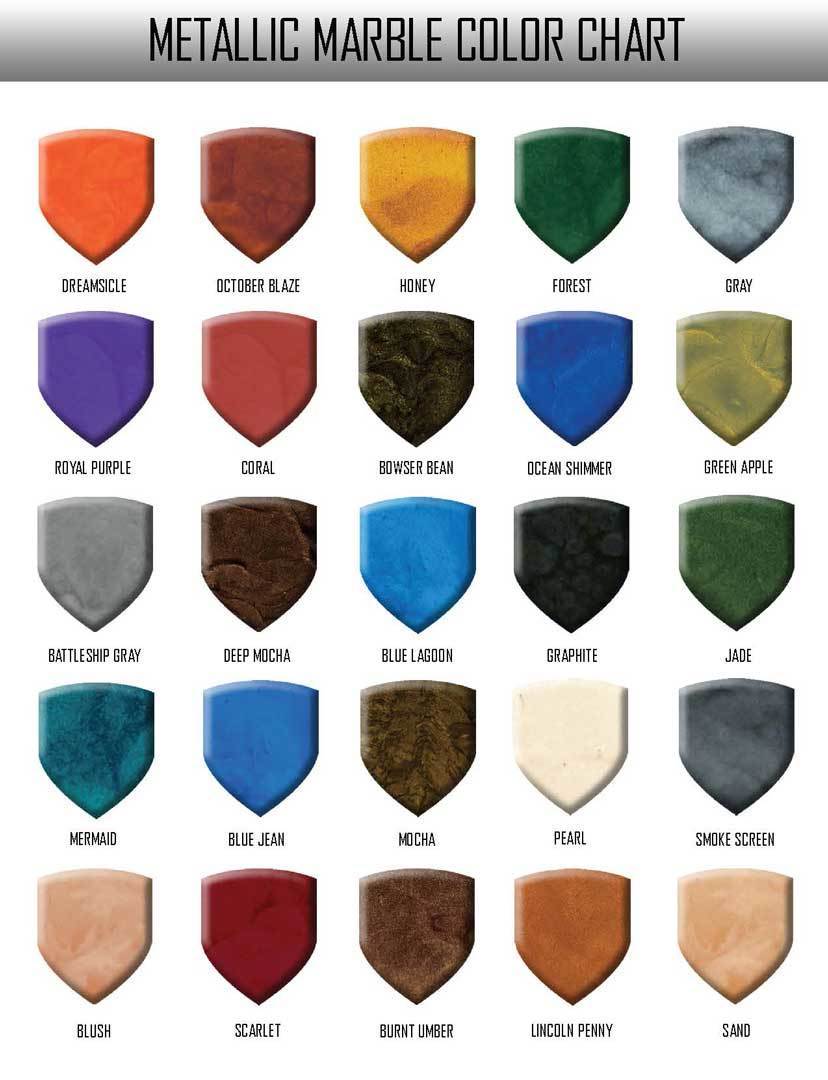
Metallic Marble Instructions
Personal Protection
It’s always recommended to wear the appropriate Personal Protective Equipment (PPE) for the task at hand and follow your employer’s safety policy. Commonly known PPE such as safety glasses, gloves, earplugs, respirators, etc, are recommended as needed.
For further information on OSHA requirements, visit osha.gov
Prep
(For in-depth instructions, see Prep Manual)
- Prep surface to be coated by shot blasting/grinding/acid washing, etc...
- Use appropriate TCP repair products to fill holes, cracks & control joints
- Thoroughly clean surface
- Protect surfaces not to be coated using specialty tape, paper, plastic, etc...
Prime Coat
- Set up mix station
- Pre-pigment desired amount of Epoxy Neat Coat Part A needed for project. It is recommended to do this the day before (1 bottle of Metallic Pigment to every 1 - 2 gallons of Epoxy Neat Coat Part A)
- Thoroughly mix Epoxy Neat Coat Part B into pre-pigmented Epoxy Neat Coat Part A for 2-3 minutes (2 parts A to 1 part B)
- Pour mixed epoxy into a “job” bucket
- Mix for additional 10-15 seconds in “job” bucket
- When using multiple colors, for each color, refer to Step #2
- Using a magic trowel, notched squeegee, or roller, apply “prime coat”
- Let dry
- Address imperfections in “prime coat” by scraping, sanding, etc…
Marble Coat
- Thoroughly mix Epoxy Neat Coat Part B into pre-pigmented Epoxy Neat Coat Part A for 2-3 minutes (2 parts A to 1 part B)
- Pour mixed epoxy into a “job” bucket
- Mix for additional 10-15 seconds in “job” bucket
- When using multiple colors, for each color, refer to Step # 2 under Prime Coat section
- Using a magic trowel, notched squeegee, or roller, apply “marble coat”
- Let dry
- Remove all protective specialty tape, paper, plastic, etc...
- Apply top coat (optional)
- Make sure project area is clean, presentable, and free from debris
Products & Coverages
- Appropriate Concrete Protector repair products (see repair manual)
- Xylene - CT-1035
- Epoxy Neat Coat (55-70 sq. ft. per gallon/ *Dry Time = 8-16 hrs.) - EN-6303
- CP Metallic Marble Pigments (1 bottle of Metallic Pigment to every 1-2 gallons of Epoxy Neat Coat Part A) - MQ-001/MQ-025
Top Coat Options
- WB 421 Gloss** (175 - 500 sq. ft. per gal./ *Dry Time = 5-7 hrs.) - UT-4501
- WB 221 Satin** (175 - 500 sq. ft. per gal./ *Dry Time = 5-7 hrs.) - UT-4499
- SLV Poly 90**(175 - 250 sq. ft. per gal./ *Dry Time = 4-8 hrs.) - UT-4513
- High Noon Acrylic Floor Finish** (1500-3000 sq. ft. per gal./ *Dry Time = 1-2 hrs.) - TJ-3113
- Satin Armor Acrylic Floor Finish**(1500-3000 sq. ft. per gal./ *Dry Time = 1-2 hrs.) - TJ-3125
* Coverages and dry times vary depending on application techniques and temperature. Estimations are based on 70 degrees, 30 percent relative humidity. For more information, refer to TDS sheets.
Tools
- 2” Green Specialty Tape - TP-7507
- Mixing Tarps - TL-7235
- Large Low Viscosity Wand - TL-7127
- ⅛” Notched Squeegee - ET-7255
- Magic Trowel (18” popular size) - TL-7103
- 4”, 9”, or 18” ⅜” Nap Roller Covers - RL-4323, RL-4341, RL-4313
- 4”, 9”, or 18” Roller Frames - RL-4325, RL-4335, RL-4319
- WTF Top Coat Roller - TCR-1001
- Roller End Caps - RL-4317
- 18” Paint Tray - RL-4309
- Threaded and Tapered Roller Poles - TL-7393, TL-7395
- Spiked Shoes - TL-7353, TL-7349
- 2” Chip Brushes - RL-4343
- Pail Opener - TL-7303
- Gloves - ET-7323
- Micro Fiber Frame, Pole and Pad - TJ-3100, TJ-3115, TJ-3119
- 5 Gallon Mixing buckets
- Low-Speed Drill
Cost & Pricing
Typical Product Cost: $1.70 - $2.30 sq. ft.
Typical Pricing: $5.50 - $10.00 sq. ft.
Benefits & Features
- Application temperatures between 55 F-85 F
- 1,000’s of color combinations
- Glow-in-the-Dark Options
- Holographic Option
- Commercial Grade Products
Above and beyond traditional concrete staining! Our industrial strength clear epoxy combined with specially formulated metallic additives creates three-dimensional color, luster, and depth in your floor.
This popular process will amaze everyone that enters your business or home. Options include additional slip resistance, gloss or satin topcoats to simulate natural marble finishes. The results are amazing! The beauty of this floor will enhance your business or home like no other.
Tips & Tricks
The MOST IMPORTANT TIP: “OUT OF THE BUCKET AND ONTO THE FLOOR” Leaving the epoxy too long in the bucket will cause it to heat up and start smoking. DO NOT POUR HOT EPOXY ON YOUR PROJECT.
- Whenever you break a kit, you must premix Part A for 3 minutes BEFORE pouring out of the bucket and adding metallic pigment to it.
- For example: If you are not using a full 1-gallon pail of Part A in the batch that you are making, you must premix the full 1 gallon of Part A (in the original bucket) before pouring out of it & adding metallic to it. If this is not done, the metallic powder may absorb additives that have risen to the top and it may have negative effects on your epoxy. If you are mixing a whole kit at once (pouring and scraping the sides of 2 complete one-gallon Part A pails into your mixing bucket), you don’t have to premix the Part A.
- 1.5 - 3 mixed gallons at a time is a typical amount to work with for each color batch (use appropriate workforce for the size of project that you are doing).
- EXAMPLE if making 3-gallon batches: The popular color combo of 50% Deep Mocha and 50% Lincoln Penny = 3 gallons x 60 sq. ft. x 2 colors = you should be working in 360 sq. ft. areas. Measure out 360 sq. ft. areas and use painters tape on the wall (each side of the room) as a visual reference to indicate each area. In this example, you are putting down 3 gallons of Deep Mocha and 3 gallons of Lincoln Penny within a 360 sq. ft. area. 360/6 gallons = 60 sq. ft. per gallon.
- It is a good idea to have each area of your whole project pre-measured & marked off before starting with your prime coat. Even though this is not as critical in the prime coat, you’ll definitely want to be getting your average of 60 sq. ft. per gallon when you get to your marble coat.
- When Magic Troweling your marble coat: Pull the epoxy across the floor to blend one color over the other and evenly cover the previous coat (use the magic trowel to pull and apply epoxy along the edges of the walls and around other obstacles). After you have your area coated, walk back into the epoxy to where you started, and lightly float the magic trowel over the surface of the colored epoxy (like washing a window with a squeegee . . . lightly floating the magic trowel over the surface of the epoxy to help level it out).
- What you don’t want is . . . make the floor to look like someone just threw paint all over the floor. All colored ribbons, drips, and puddles should be manipulated with your magic trowel, rollers or a combination of these to “smear” one color over top of and with the other colors to blend and marbleize.
- Single Metallic colors look great as well as 2 color combos. Keep in mind that the more colors you do, the more complex the project becomes (with a greater chance for error).
- Use The Concrete Protector’s large low viscosity mixing wand for mixing. This is the correct mixing wand to ensure that you are not whipping air into your epoxy.
- Do not use a high-speed drill. Do not mix so fast that you get the “tornado effect” in the product as it spins around the bucket (at this speed, you may suck air down into the epoxy . . . potentially entrapping it and possibly causing bubbles).
- Make sure the room is at a steady temperature or the temperature is on the decrease when applying the epoxy. A room with floor temps rising while curing may cause the slab to breathe out and possibly cause outgassing bubbles).
- Do whatever it takes to control room temps. If it means putting aluminum foil on the windows to block and reflect the sun, then do it.
- It is highly recommended to have ALL of your Marble Coat batches premeasured ahead of time (for both colored Part A Resin & Part B Hardener). This is called “batching”. This way, all your mixer has to do is pour the Part B into the colored Part A and then mix. The less thinking involved in the mixing step, the less chance there is for mistakes.
- Use the appropriate labor force for the job that you’re doing. Most residential projects may require 3 workers. One person dedicated to mixing only. One person as your “runner”, taking buckets of mixed epoxy from the mixing area to the floor, and one person as the main applicator/finisher.
- Mark all “job” buckets to visually indicate the job buckets from mixing buckets. Apply painters tape around the buckets that you are designating as “job buckets” to clearly indicate which buckets are job buckets and which buckets are mixing buckets. You DO NOT want to take mixing buckets (with possible unmixed Part A or B dripping off the bottom of it from a messy mixing station) onto your floor.
- When mixed epoxy is poured into your job bucket, make sure that the job bucket is sitting on a clean surface.

